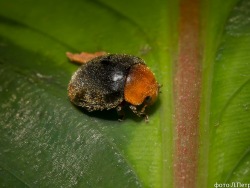The Tropical Rainforest Exhibit Has Got Predatory Bugs

Cryрtolaemus montrоuzieri bugs feeding on insect pests were released into the Tropical Rainforest Exhibit several days ago.
“We started planting the Tropical Rainforest two years ago – yet before official opening of the Primorsky Aquarium,” Svetalana Serkova, Head of the Tropical Rainforest Departmen tells. “Due to the open system we have, insect pests got inside the exhibit with airflows and on the visitors’ clothes. Being microscopic - smaller than dust motes, these insects under optimal environmental conditions (temperature and moisture) and all-year availability of succulent plants have actively multiplied. Since we cannot use pesticide chemicals, then to avoid harming tropical freshwater fishes living in the exhibit, we decided on a biological method of the rainforest plant protection.”
Biological control of pests is a method of controlling pests and diseases in agriculture that relies on natural predation rather than introduced chemicals; it is getting widespread use as an advanced and environmentally friendly method. Native to Australia, the Cryрtolaemus species has been used in agriculture as a biological control agent against scale insects throughout the world. Outside Australia, C. montrouzieri has the common name Mealy bug destroyer.
Cryрtolaemus belongs to Coccinellidae family and has typical ladybird shape, about 6 mm in length, with black bright elytra and orange-brown head, antennae, pronotum and the legs.
Svetlana Serkova says, “Getting into new environment the bugs migrate through the exhibit in search of food organisms. They fly out on walks and land on lamps and stands. We have to collect them and give back to the plants. We ask visitors to be unafraid and do not crush our amiable helpers. When the bugs oecize, they will support their population themselves.”
About the Tropical Rainforest Exhibit:
- The Tropical Rain Forest Exhibit is one of the most thickly settled Aquarium’s exhibits, with ground vegetation representatives. There are more than 1,500 specimens of living plants collected here. At the high rocks, there are replica plants made with scientific accuracy. Some two-meter trees are granted by Vladivostok citizens.
- The exhibit is located in two-level hall, an eight-storied house high. The life support system maintains hot temperature and high humidity typical of tropical rainforests. Amazon River’s fishes live in aquariums of the exhibit. The exhibit demonstrates all the beauty, specificity, and biodiversity of different tropical rainforest levels.
09/01/2017